| Srl | Item |
| 1 |
ID:
102291
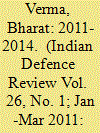

|
|
|
| 2 |
ID:
091843
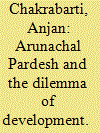

|
|
|
|
|
| Publication |
2009.
|
| Summary/Abstract |
The economy of Arunachal Pardesh is growing at a yearly average of more than 7 percent, and its per capita income is more than Rs. 20000. The share of agriculture to Gross State Domestic product is declining and industry and services are increasing.
|
|
|
|
|
|
|
|
|
|
|
|
|
|
|
|
| 3 |
ID:
096336
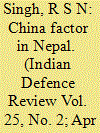

|
|
|
| 4 |
ID:
114356
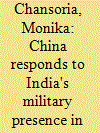

|
|
|
| 5 |
ID:
100254
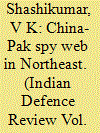

|
|
|
| 6 |
ID:
096332


|
|
|
| 7 |
ID:
192938
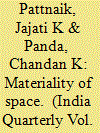

|
|
|
|
|
| Summary/Abstract |
The materiality of space refers to the material constituents determining the space. The spatial imagination of the borderland, characterised by critical spatiality, is materially constituted. The fact of being materially constituted means to be infrastructurally configured. The infrastructures here include hydro projects, highways, railroads, bridges, tunnels, airports, digital connectivity and other defence-related installations. These projects combine a two-pronged approach: security and development. The security challenges that the border space embodies compel the state to adopt an approach of competitive infrastructure building. The nature of this competition is determined by the competing other’s approach towards the border space. Arunachal Pradesh is a very critical border state that shares its crucial border space of 1,080 km with China, 160 km with Bhutan and 440 km with Myanmar. China’s increasing geopolitical clout in the region intensifies its spatial and material prominence. India under its Act East Policy (AEP) formulation in 2014 has taken up a very determined approach to accelerating infrastructure growth in the northeast and more particularly in Arunachal Pradesh for its border spatiality. Therefore, the border space loses its inferential, conjectural and abstract character and becomes materially determined. This imperative for materiality embodies, on the one hand, development, modernity, capitalist social space and mainstreaming of the neglected and, on the other hand, protectionism and upgradation of security architecture along critical geography known as the border space. Therefore, this study examines the development of materiality, meaning infrastructure, in a complex border space like Arunachal Pradesh. It decodes the economic logic of the systematic development of border space by the Indian nation-state from the point of view of the growth of the region and security urgency. It uses Henri Lefebvre’s theoretical formulations of spatiality to understand the convoluted category of border space and the introduction of material forces to achieve security and developmental objectives.
|
|
|
|
|
|
|
|
|
|
|
|
|
|
|
|
| 8 |
ID:
089743


|
|
|
|
|
| Publication |
2009.
|
| Summary/Abstract |
Defence Minister of India, Mr.A K Antony visited Nathu La in East Sikkim in the first week of December 2007 and was visibly taken aback to see the difference between infrastructure on the Indian and the Chinese sides. Mr. Antony termed the visit as an eye opener.He was candid enough to accept that the infrastructure on the Chinese side was far superior and promised to take urgent steps to develop frontier areas.
|
|
|
|
|
|
|
|
|
|
|
|
|
|
|
|
| 9 |
ID:
111277
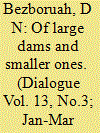

|
|
|
| 10 |
ID:
116203
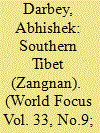

|
|
|
| 11 |
ID:
095136
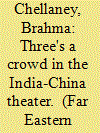

|
|
|